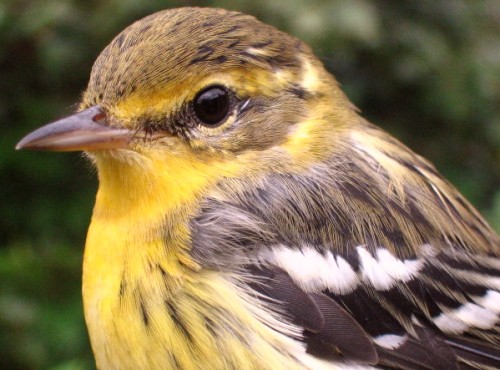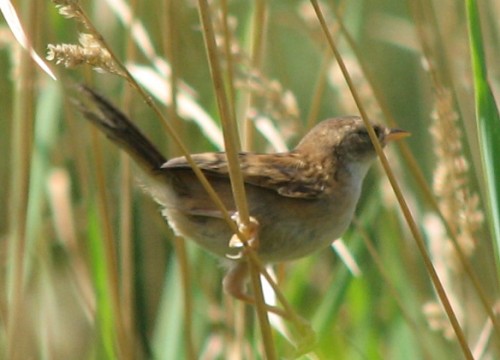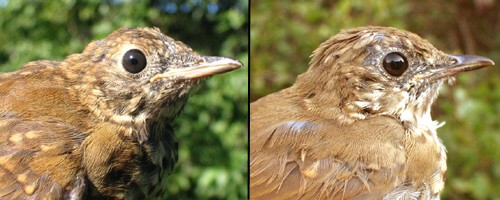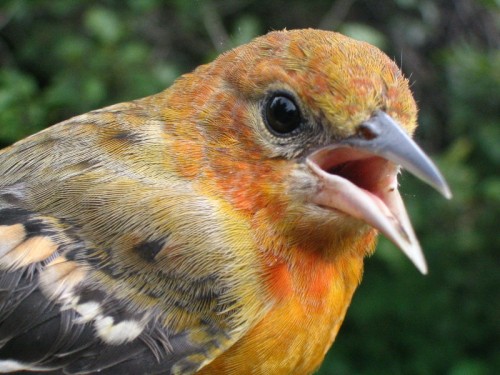|
McGILL BIRD OBSERVATORY |
||||||||||||||||||||||||||||||||||||||||||||||||||||||||||||||||||||||
Welcome
to the McGill Bird Observatory weekly report.
Click here for a complete listing of our archives.
Bander-in-charge:
Seabrooke Leckie Notes: Week two got off to an excellent start with the shift of the winds from south on the 7th to northwest on the 8th as a cold front moved in, bringing with it birds from the north. A total of 43 new birds were banded on Tuesday, with birds remaining active later into the morning in the cooler weather. The catch consisted predominantly of Song Sparrows, Baltimore Orioles, and Rose-breasted Grosbeaks which were encountered throughout the morning in small flocks. Wednesday dawned even cooler, but the winds had shifted back to the southwest, stalling any further large movement. However, despite the lower banding totals, ones and twos of some new species were observed, including season firsts of Scarlet Tanager, Cape May Warbler and Northern Waterthrush. One of two exciting species that turned up this week was observed late in the morning near the parking area: a Sedge Wren, discovered by Barbara Frei, represents the first record for MBO! The photographic proof is below.
Overcast periods kept bird activity a bit lower on the 10th, but several new species were captured in the nets. Undoubtedly the banding highlight of the week was a HY Blackburnian Warbler, only the second of this species banded by MBO to date. As if that weren't enough, a Warbling Vireo captured late in the morning is just the fourth for the station. New arrivals continued to trickle in with the addition of Wilson's and Canada Warblers. Despite north winds overnight, activity was generally low on Friday. The early-morning air was full of the 'tsee' call notes of Song Sparrows, a distinctive sound of autumn, whose numbers peaked on this day. A large flock of 14 birds, nearly all Song Sparrows, were caught in one net on the first round, but the rest of the day was mostly quiet. The first Ruby-crowned Kinglet, an early AHY undergoing her fall moult, was captured late in the morning. A total of nine warbler species was tallied at the end of the day including new arrivals Black-throated Green and Bay-breasted Warblers. Things continued slow for the 12th, with just 18 new birds banded, the second lowest total since the beginning of the season. Because of the combination of few birds and reasonable staffing, the L net group was opened for the first time this season. Hopes were to catch some of the warblers that were moving through the area, but it didn't fare much better than the rest of the nets. The first Chestnut-sided Warbler was banded, along with singles of Tennessee and Canada. A Solitary Sandpiper spotted on the back ponds was new for the season. Cool temperatures and the shifting of winds from west to northwest overnight brought in another small push of birds for the 13th. Song Sparrows continued to be among the most abundant birds at the site, with 15 banded. Small numbers of Baltimore Orioles and a few warblers were also present. The second exciting bird of the week was a Caspian Tern heard calling as it flew over the site to the west early in the morning, also the first record of the species for the station! The final day of the period, the 14th, was the busiest of the season so far. A total of 64 birds were captured, the majority of which were during the first two net rounds. Highlights included the season's first Philadelphia Vireo and Black-throated Blue Warbler, both banded. A species total of 51 for the morning tied our previous season high, but warblers showed the most diversity of the season so far with a total of 13 species detected at the site.
While Song Sparrow remains at the top of the list of species banded on the week, the increase in numbers of Baltimore Orioles and Rose-breasted Grosbeaks, as well as the addition of several new species to the list, predominantly warblers, indicates that migration is gearing up into full swing!
|





